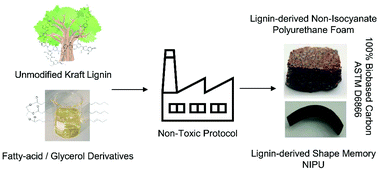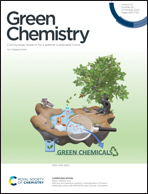Materials for the biorefinery: high bio-content, shape memory Kraft lignin-derived non-isocyanate polyurethane foams using a non-toxic protocol†
Abstract
Polyurethanes are among the top six polymers produced in the world and are widely used in the automotive, furniture, construction and appliance industry for their light weight, impact resistance, and insulating properties. However, the use of hazardous diisocyanates used in polyurethane formulations has led many to search for more sustainable alternatives. The lignin component of biomass has been targeted to replace the often toxic and petroleum-derived precursors to polymer synthesis in support of the biorefinery concept where natural materials are used as the feedstock for commodity plastics. The use of lignin is often hampered due to its low reactivity, heterogeneity and the necessity of employing extensive purification and/or functionalization measures to ensure materials are of comparable quality. In this report, a unique method is presented for the synthesis and processing of a non-toxic, non-isocyanate polyurethane foam utilizing unmodified Kraft lignin and a biobased curing agent. Raw Kraft lignin is functionalized with green organic carbonates and a non-toxic approach is taken to solubilize the precursors with a curing agent from renewable fatty acids enabling rapid gel-times. For the first time, a NIPU foam from lignin is synthesized while the structure–property relationship of different reaction mixtures is studied demonstrating shape memory capacity and 100% biobased carbon content.



 Please wait while we load your content...
Please wait while we load your content...
